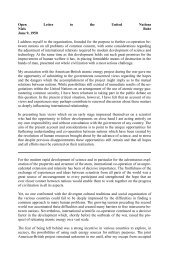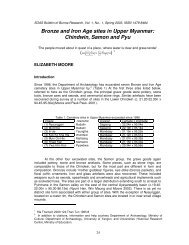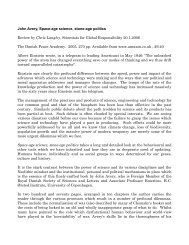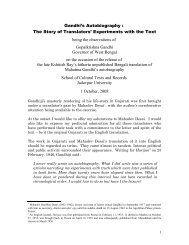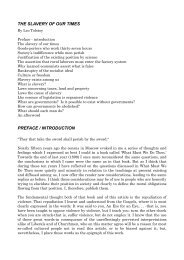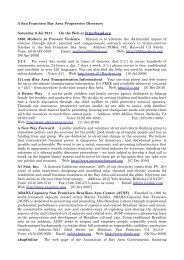History in the new South Africa: an introduction - Det danske ...
History in the new South Africa: an introduction - Det danske ...
History in the new South Africa: an introduction - Det danske ...
Create successful ePaper yourself
Turn your PDF publications into a flip-book with our unique Google optimized e-Paper software.
16 The impact of <strong>the</strong> AIDS epidemic <strong>in</strong> <strong>South</strong> <strong>Africa</strong><br />
By He<strong>in</strong> Marais<br />
<strong>History</strong> has not been k<strong>in</strong>d to <strong>South</strong> <strong>Africa</strong>. 30 After centuries of colonialism came one of <strong>the</strong><br />
most ferocious systems of <strong>in</strong>stitutionalized racism <strong>the</strong> world has known. For almost 50 years,<br />
apar<strong>the</strong>id wreaked havoc <strong>in</strong> <strong>the</strong> lives of black <strong>South</strong> <strong>Africa</strong>ns while secur<strong>in</strong>g for whites<br />
possibly <strong>the</strong> highest st<strong>an</strong>dard of liv<strong>in</strong>g <strong>in</strong> <strong>the</strong> develop<strong>in</strong>g world. By <strong>the</strong> early 1990s, after a<br />
long liberation struggle, <strong>the</strong> country was beg<strong>in</strong>n<strong>in</strong>g to extricate itself from its ignom<strong>in</strong>ious<br />
past. The future seemed to be <strong>the</strong>re for <strong>the</strong> mak<strong>in</strong>g—except that <strong>the</strong> country now found itself<br />
<strong>in</strong> <strong>the</strong> path of a swiftly-grow<strong>in</strong>g AIDS epidemic which, <strong>in</strong> a few years, would become <strong>the</strong><br />
worst such epidemic <strong>in</strong> <strong>the</strong> world.<br />
As <strong>South</strong> <strong>Africa</strong>ns voted <strong>in</strong> <strong>the</strong>ir first democratic election <strong>in</strong> April 1994, few were th<strong>in</strong>k<strong>in</strong>g<br />
about AIDS, <strong>an</strong>d even fewer had <strong>an</strong> <strong>in</strong>kl<strong>in</strong>g of what <strong>the</strong> epidemic held <strong>in</strong> store for <strong>the</strong>m <strong>an</strong>d<br />
<strong>the</strong>ir country. A mere four years earlier, it had been estimated that less th<strong>an</strong> 1% of adult <strong>South</strong><br />
<strong>Africa</strong>ns were <strong>in</strong>fected with HIV, <strong>the</strong> virus that causes AIDS. An endur<strong>in</strong>g sense of<br />
exceptionalism encouraged <strong>the</strong> notion that <strong>South</strong> <strong>Africa</strong>, somehow, would evade <strong>the</strong> serious<br />
epidemics underway <strong>in</strong> o<strong>the</strong>r parts of East <strong>an</strong>d Sou<strong>the</strong>rn <strong>Africa</strong>. The Communist Party leader<br />
Chris H<strong>an</strong>i was one of <strong>the</strong> rare public figures to have recognized <strong>the</strong> threat. In 1990, he had<br />
told conference-goers <strong>in</strong> Maputo that:<br />
Those of us <strong>in</strong> exile are especially <strong>in</strong> <strong>the</strong> unfortunate situation of be<strong>in</strong>g <strong>in</strong> <strong>the</strong> areas where <strong>the</strong><br />
<strong>in</strong>cidence of this disease is high. We c<strong>an</strong>not afford to allow <strong>the</strong> AIDS epidemic to ru<strong>in</strong> <strong>the</strong><br />
realization of our dreams. Exist<strong>in</strong>g statistics <strong>in</strong>dicate that we are still at <strong>the</strong> beg<strong>in</strong>n<strong>in</strong>g of <strong>the</strong><br />
AIDS epidemic <strong>in</strong> our country. Unattended, however, this will result <strong>in</strong> untold damage <strong>an</strong>d<br />
suffer<strong>in</strong>g by <strong>the</strong> end of <strong>the</strong> century. 31<br />
HIV data highlight two prime features of <strong>South</strong> <strong>Africa</strong>’s epidemic: <strong>the</strong> astonish<strong>in</strong>g speed with<br />
which it evolved (national adult HIV prevalence of less th<strong>an</strong> 1% <strong>in</strong> 1990 rocketed to almost<br />
25% with<strong>in</strong> 10 years), <strong>an</strong>d its extraord<strong>in</strong>ary <strong>in</strong>tensity. When voters went to <strong>the</strong> polls for <strong>the</strong><br />
country’s second-ever democratic election <strong>in</strong> 1999, at least 3 million <strong>an</strong>d possibly as m<strong>an</strong>y as<br />
4 million <strong>South</strong> <strong>Africa</strong>ns were liv<strong>in</strong>g with HIV, <strong>the</strong> virus that causes AIDS. 32 By 2006, that<br />
number had surpassed 5 million (ASSA, 2005). 33<br />
30 This article is based on He<strong>in</strong> Marais’s book Buckl<strong>in</strong>g: The impact of AIDS <strong>in</strong> <strong>South</strong> <strong>Africa</strong>, published by <strong>the</strong><br />
Centre for <strong>the</strong> Study of AIDS at Pretoria University. An electronic version is available at<br />
http://www.sarpn.org.za/documents/d0001789/<strong>in</strong>dex.php<br />
31 Chris H<strong>an</strong>i, speak<strong>in</strong>g at <strong>an</strong> AIDS conference <strong>in</strong> Maputo, Mozambique, 1990, cited <strong>in</strong> Marais H (2000). To <strong>the</strong><br />
edge: AIDS Review 2000. Pretoria, Centre for <strong>the</strong> Study of AIDS.<br />
32 The Actuarial Society of <strong>South</strong> <strong>Africa</strong>’s (ASSA) AIDS models are among <strong>the</strong> most sophisticated of <strong>the</strong>ir k<strong>in</strong>d.<br />
The 1999 figure is derived from <strong>the</strong> ASSA 2002 model, which retrospectively estimated that 3.2 million <strong>South</strong><br />
<strong>Africa</strong>ns were liv<strong>in</strong>g with HIV <strong>in</strong> that year. Us<strong>in</strong>g less nu<strong>an</strong>ced assumptions <strong>an</strong>d data, UNAIDS/WHO (2000)<br />
estimated <strong>the</strong>re were 4.2 million <strong>South</strong> <strong>Africa</strong>ns with HIV at <strong>the</strong> end of 1999.<br />
33 ASSA (2005). ASSA 2003 AIDS <strong>an</strong>d demographic model. Cape Town, ASSA. For a summary, see<br />
http://www.assa.org.za/scripts/file_build.asp?id=100000538&pageid=1000000022. The latest estimates of <strong>the</strong><br />
Actuarial Society of <strong>South</strong> <strong>Africa</strong> are that 5.2 million <strong>South</strong> <strong>Africa</strong>ns were liv<strong>in</strong>g with HIV <strong>in</strong> 2005, compared<br />
with <strong>the</strong> Jo<strong>in</strong>t United Nations Programme on AIDS (UNAIDS) estimate of 5.5 million.





